Deep dive: Admission rates across South Africa's four COVID-19 waves confirm Omicron-driven fourth wave's lower severity, and more.

Across a host of measures - from admission rates to ward acuity and length of hospital stay - the Omicron (B.1.1.529)-driven fourth wave was lower in severity than past waves of infection. These dynamics are fed by Omicron's lowered pathogenicity, vaccination rates and population-wide seropositivity.
Authors
Chana Suttner (Actuary, Discovery Health),Michael Cohen (Actuarial Analyst, Discovery Health), Shirley Collie (Chief Healthcare Analytics Actuary, Discovery Health
Omicron fuels South Africa's fourth wave of COVID-19, from late 2021 into early 2022
The original Omicron variant (B.1.1.529) of SARS-CoV-2 was first identified in Southern Africa during November 2021. It was brought to the world's attention by scientists in South Africa and Botswana and declared a Variant of Concern by the World Health Organization shortly thereafter.
South Africa experienced rapid Omicron community spread, initially concentrated in the Gauteng province. Over the course of December 2021 and into early 2022, this highly transmissible variant replaced the formerly dominant Delta variant and drove an exponential rise in COVID-19 cases - South Africa's fourth wave of infection.
Given the increased transmissibility of the Omicron variant compared to prior COVID-19 viral variants, it quickly became important to predict the severity of illness this variant might cause - and the consequent COVID-19 hospital admission rates that could result over the fourth wave.
- In mid-December 2021 we released a fundamental preliminary analysis (world-first data from the first three weeks of South Africa's fourth wave) showing the Omicron (B1.1.529) variant's decreased tendency to cause serious COVID-19 illness - data well received by global media.
- At the end of March 2022, we released an updated analysis confirming the Omicron (B1.1.529) variant's decreased tendency to cause serious COVID-19 illness, compared to the Delta variant (which drove South Africa's third wave of infection).
Now, in our third analysis we look more deeply into hospital admissions recorded during South Africa's fourth wave of COVID-19 infection. We followed a simple descriptive data approach and did not adjust the data for any differences between categories or confounders variables. That said, it is true that variables such as age, sex, vaccination status and having recovered from a prior documented infection are very likely to contribute to the difference in disease severity observed across waves of infection. We did not take these into account.
Our methodology
Administering 3.7 million medical scheme members means Discovery Health has extensive claims and private health system use data and is therefore uniquely positioned to generate at-scale, real-world insights into the impact of COVID-19.
This investigation looked at COVID-19 infections, admissions, and vaccination status.
Data spanned 1 March 2020 to 24 March 2022 and included a sample of 586,869 adult medical scheme members.
We included adult and child scheme member admissions and looked at:
- Likelihood of COVID-19 admission after contracting COVID-19
- Nature of admission:
- COVID-19 related versus unrelated admission rates
- Lengths of hospital stay
- Ward to which COVID-19 patients were admitted (ICU, High Care or General Ward)
- Comparison of vaccinated and unvaccinated member experience
Duration of each of South Africa's four waves of infection
Table 1 depicts the start and end dates selected for the dominant period of each Variant of Concern, defined for the purposes of our comparison.
These periods are established through research by experts involved in the Network for Genomic Surveillance in South Africa. The table below depicts the overall national start and end dates for the different waves. These dates have also been defined on a provincial level (see Appendix 1). Both national and provincial timelines are used throughout the investigation.
| Dominant variant | Start date | End date |
|---|---|---|
| D614G | 1 March 2020 | 19 November 2020 |
| Beta | 20 November 2020 | 16 May 2021 |
| Delta | 17 May 2021 | 14 November 2021 |
| Omicron | 15 November 2021* | Analysis conducted up to 24 March 2022. |
Table 1: Periods over which four distinct SARS-CoV-2 variants were dominant in South Africa.
Our results: A comparison of adult and child infection, admission, and death rates across the third (Delta-driven) and fourth (Omicron B.1.1.529)-driven waves of infection.
Comparing South Africa's third, Delta-driven wave of infection with the fourth Omicron-driven wave of infection we see quite a different adult and child admission and mortality experience.
In adults (Figure 1):
- The peak 7 seven-day moving average in COVID-19 infections was similar in the Delta-driven third wave (17 May 2021 to 14 November 2021) and Omicron-driven fourth wave (see figure 1). However, a lower severity of infection (cases) was recorded during the fourth wave, and here there was a distinct decoupling between infections and admissions and mortality (death) rates.
- The peak 7 seven-day moving average in COVID-19 admissions in the Omicron-driven wave was 61% lower than that seen in the Delta-driven wave
- The peak 7 seven-day moving average in COVID-19 related deaths in the Omicron-driven wave was 88% lower than that seen in the Delta-driven wave
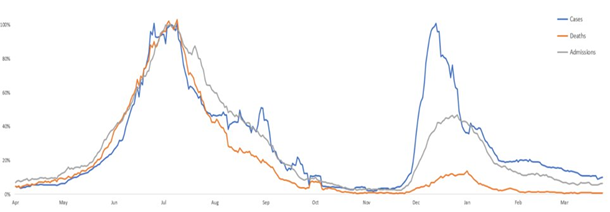
Figure 1: COVID-19 infections, admissions, and deaths in adults (aged 18 and over) during the Delta-driven third wave and Omicron-driven fourth wave in South Africa.
During the fourth wave, more child medical scheme members (29%) tested positive for COVID-19 than adults (26%). This is possibly due to children returning to schools and so to in-person learning at the start of 2022. It could also be linked to low vaccination rates amongst 12- to 17-year-old children at the time, and lack of vaccinations for children under the age of 12.
- By 24 March 2022, 22% of Discovery Health administered scheme members aged 12 to 17 had been vaccinated for COVID-19.
COVID-19 infection is for the most part mild in children, and there have been very few child deaths. That said, (Figure 2):
- We see a higher number of child infections and admissions at the peak of the Omicron-driven fourth wave compared to peak of the Delta-driven third wave.
- Also, overall, over the fourth wave there were more child than adult admissions to hospital - 7% (1,725) of COVID-19 positive children were admitted compared to 5.8% (7,181) of adults who had COVID-19.
- The peak 7 seven-day moving average in child COVID-19 infections in the Omicron-driven wave was 7% higher than that seen in the Delta-driven wave.
- The peak 7 seven-day moving average in child COVID-19 admissions in the Omicron-driven wave was 189% higher than that seen in the Delta-driven wave.

Figure 2: COVID-19 infections, admissions, and deaths in children (younger than aged 18) during the Delta-driven third wave and Omicron-driven fourth wave.
Furthermore, as shown in Figure 3:
- Infants (scheme members younger than one year of age) experienced the highest proportion of admissions across age groups, in all waves of infection.
- In children aged 1 to 4, the Omicron variant admission rate (19%) was the second highest admission rate for children across all variants, with the highest recorded in the Beta-driven second wave of infection at 20%.
- For adults, the admission rate during the Omicron-driven fourth wave (6%) was less than half of that recorded during prior waves of infection.
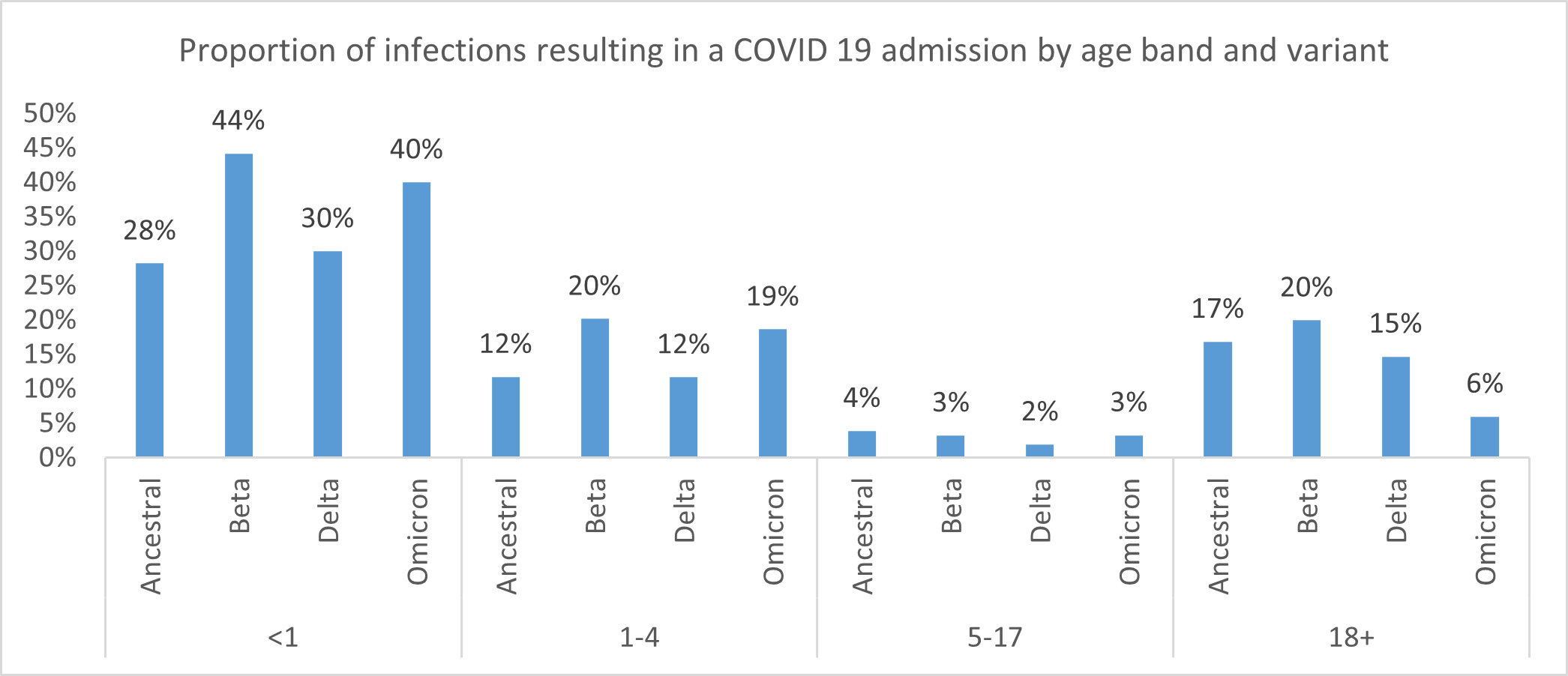
Figure 3: Proportion of infections resulting in a COVID-19 related admission by age band and variant
Rates of COVID-related versus unrelated admissions in scheme members who tested positive for COVID-19
During the Omicron-driven fourth wave of infection, 58% (7,170) of medical scheme members admitted to hospital were admitted for COVID-19 (see Figure 4), and mostly for pneumonia treatment. We call these admissions "COVID-19 admissions".
And 42% of admissions (where people tested positive for COVID-19) were unrelated to COVID-19.
- Admissions unrelated to COVID-19 are identified by using a clinical exclusion list, and Discovery Health's Diagnosis Related Grouper. Examples include admissions for elective surgeries or trauma admissions. Here members tested positive for COVID-19 likely during routine pre-admission testing, but their admission was not related to typical COVID-19 treatment.
During the Omicron-led fourth wave of infection, COVID-19 related admissions (58% of admissions) made up a smaller proportion of total admissions than they did in previous waves.
In previous waves, the percentage of members admitted for COVID-19 treatment was:
- 79% (14,422) in the ancestral/D614G-driven first wave
- 86% (20,518) in the second/Beta-driven wave
- 84% (30,793) in the third/Delta-driven wave.
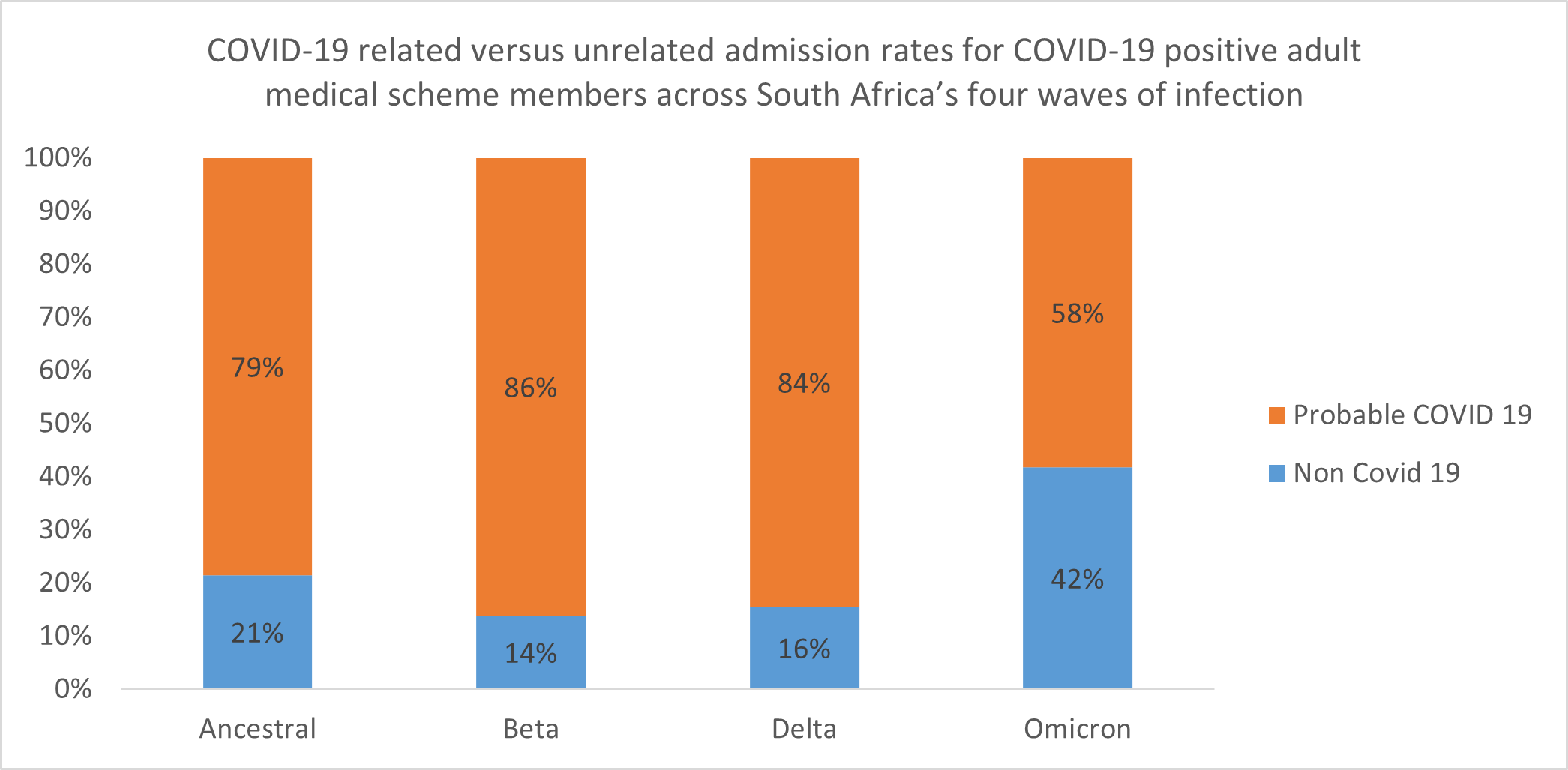
Figure 4: COVID-19 related versus unrelated admission proportions for COVID-19 positive adult medical scheme members across South Africa's four waves of infection.
Investigating the type of ward (ward acuity) to which members were admitted through each wave of infection, as a proxy for their disease severity
The type of ward to which medical scheme members admitted for COVID-19 - whether ICU, High Care or a General Ward - is a potential indicator of the severity of their COVID-19 illness.
An analysis of admission data (without adjusting for confounders such as vaccination status and age) indicates that fourth wave COVID-19 infections were less severe than those experienced in previous waves:
- There was a slightly higher proportion of General Ward admissions during the fourth wave, at 69% (4,979) of all admissions, compared to levels at 61% to 65% of admissions in previous waves.
- During the Omicron-driven fourth wave, there were fewer ICU admissions - 14% (1,043 admissions) of all admissions - than in prior waves. In past waves ICU admissions made up 21% to 23% of admissions.
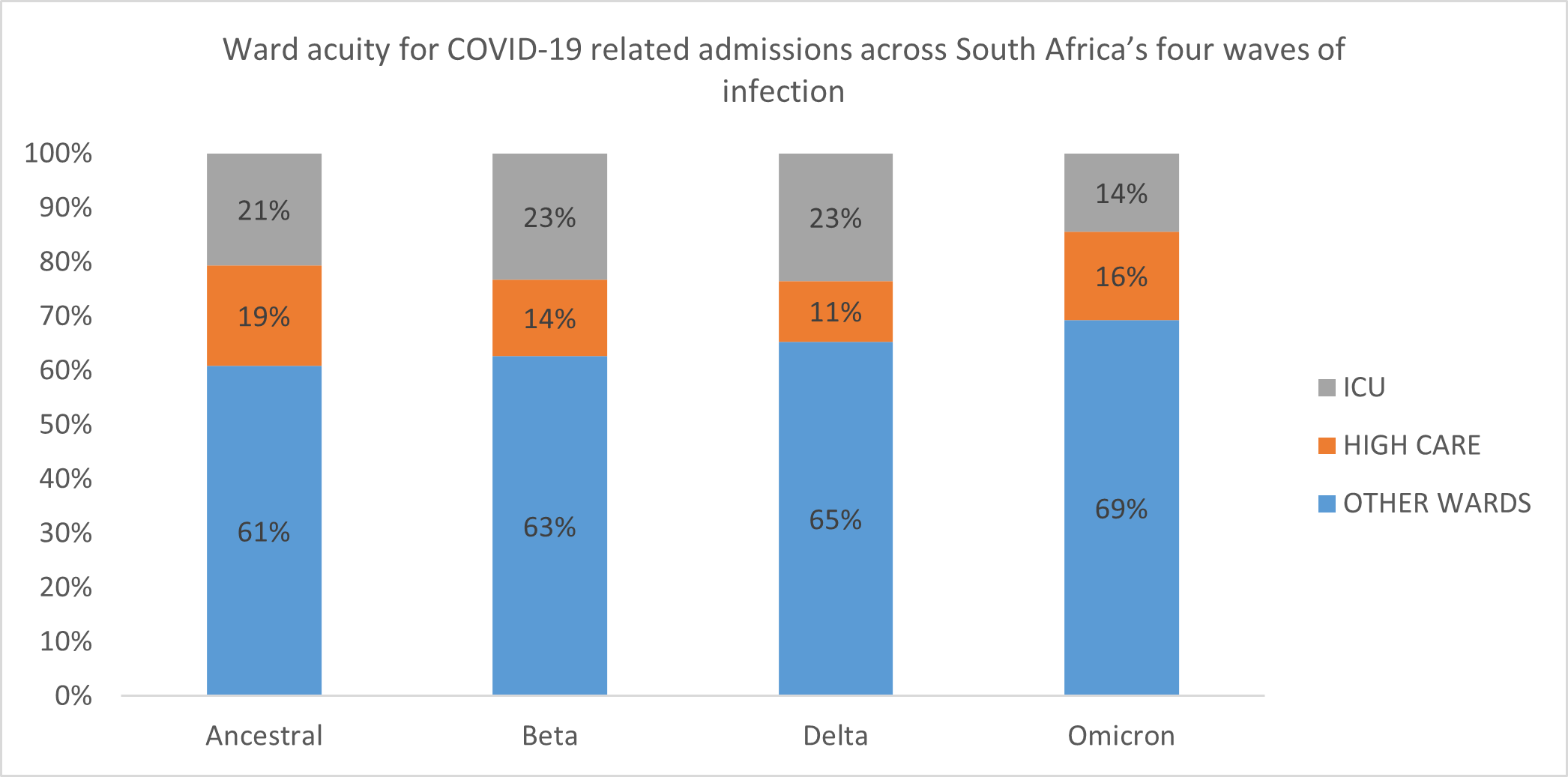
Figure 5: Ward acuity for COVID-19 related admissions across South Africa's four waves of infection
Comparing average lengths of hospital stay across hospital ward types in each of South Africa's four waves of infection
Looking at admissions for COVID-19 treatment for adult medical scheme members, across all four waves of infection, we find the average length of stay in ICU, high care and in general wards was lower in the Omicron-driven fourth wave than it was in previous waves of infection (Figure 6).
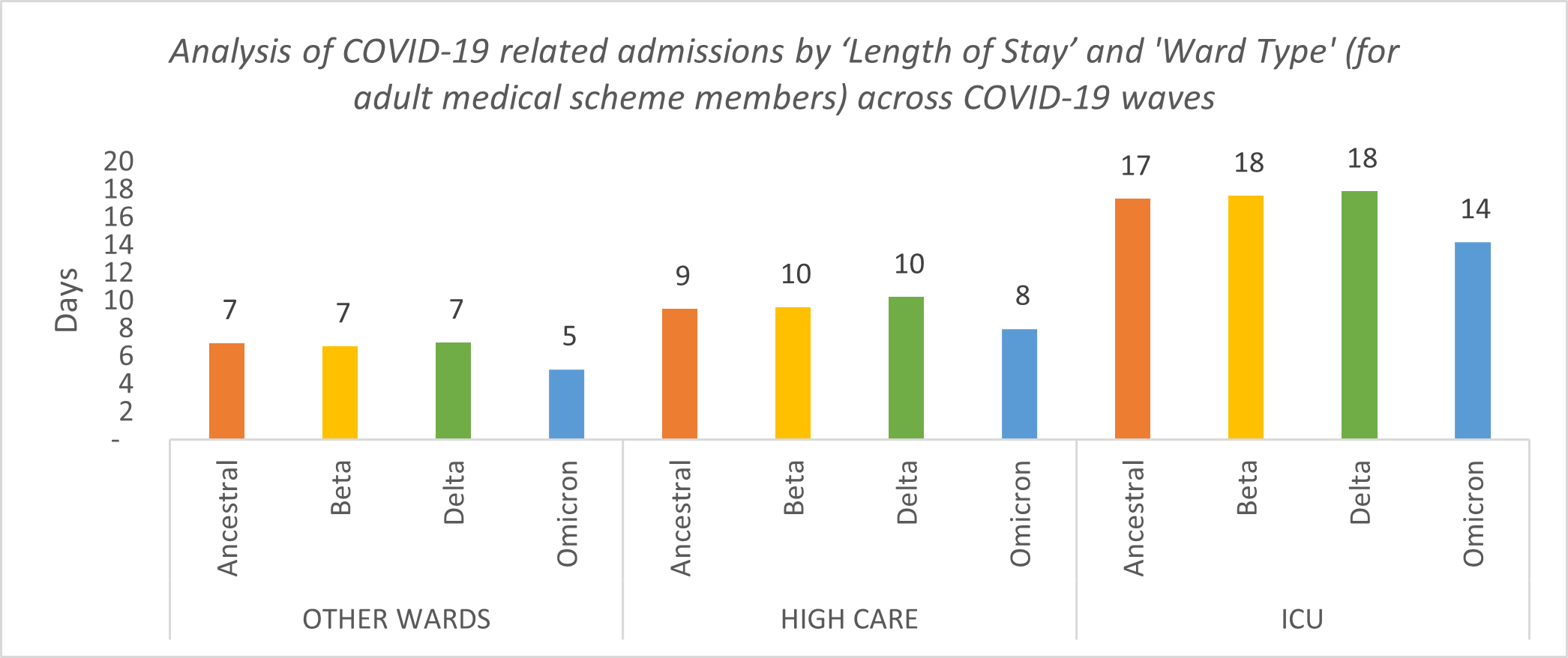
Figure 6: Analysis of COVID-19 related admissions by 'Length of Stay' and Ward Type (for adult medical scheme members)
Admission rates for vaccinated and unvaccinated medical scheme members in the Delta-driven third wave and Omicron-driven fourth wave.
The Delta-driven third wave (17 May to 14 Nov 2021) coincided with the first opportunity for widespread vaccine uptake in the Discovery Health adult medical scheme member population.
Figure 7 shows:
- More medical scheme members were admitted for COVID-19 in the Delta-driven wave than in the Omicron-driven wave.
- In both waves more unvaccinated people were admitted than fully or partially vaccinated individuals (without adjusting for confounders, such as age).
- In the Delta-driven third wave, 15% of unvaccinated members with a documented infection were admitted and 13% of fully or partially vaccinated members were admitted.
- In the Omicron-driven wave, 8% of unvaccinated members with a documented infection were admitted and 5% fully or partially vaccinated members with documented infection were admitted.
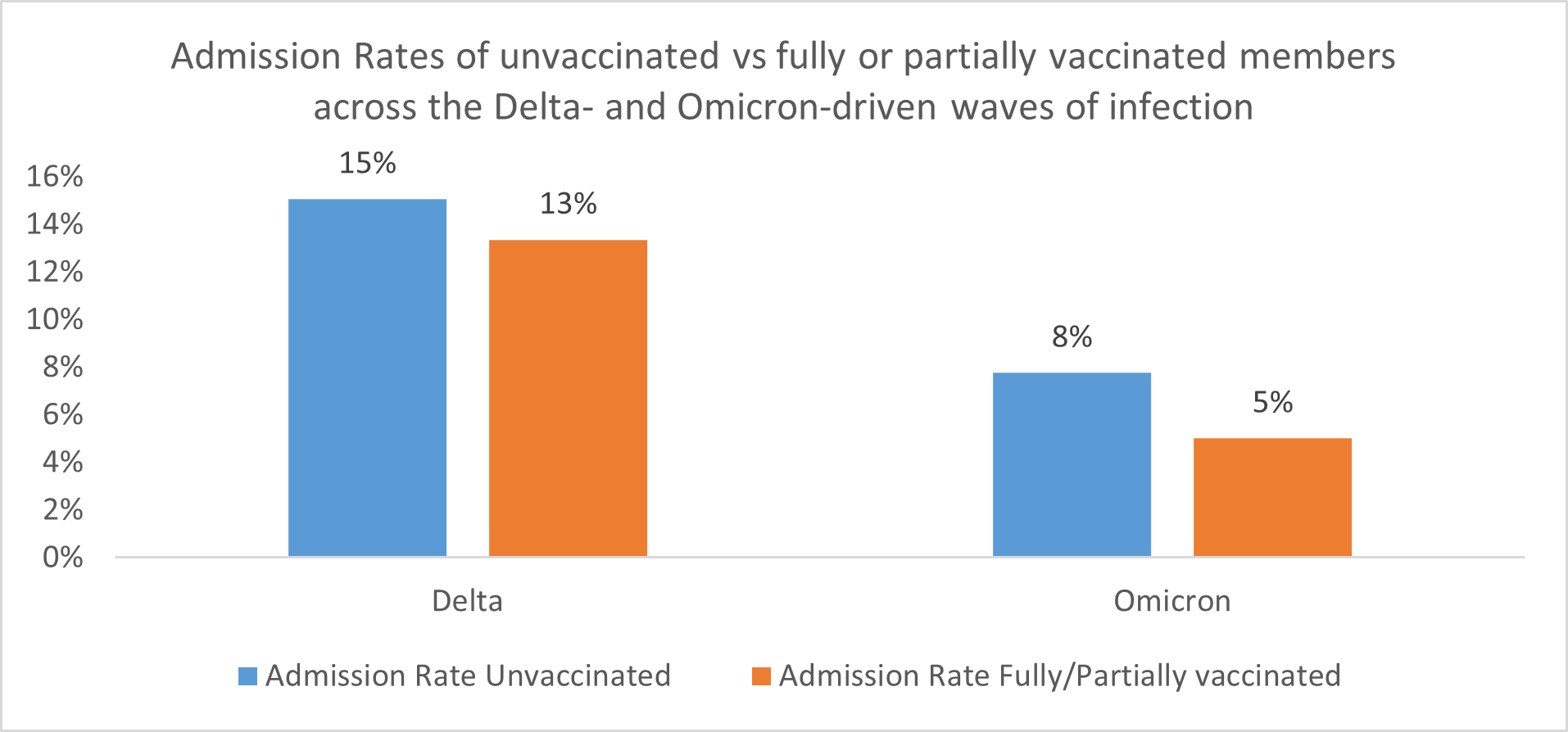
Figure 7: Admission rates of unvaccinated versus fully or partially vaccinated medical scheme members across the Delta-driven third wave and Omicron-drive fourth wave
Lengths of hospital stay and ward acuity for vaccinated and unvaccinated medical scheme members admitted to hospital during the Delta-driven third wave and Omicron-driven fourth wave.
Not only were fully or partially vaccinated adult medical scheme members less likely to be admitted to hospital during the third and fourth waves, but, where they were admitted, they showed a shorter length of stay and lower ward acuity (Figure 8) compared to the unvaccinated.
During both the Delta- and Omicron- driven waves:
- The average length of hospital stay for fully or partially vaccinated individuals was lower than for unvaccinated individuals.
- The average number of days per admission, spent in higher acuity settings (ICU and High Care) was also reduced among fully or partially vaccinated individuals, potentially indicating a lower severity of admissions in this group.
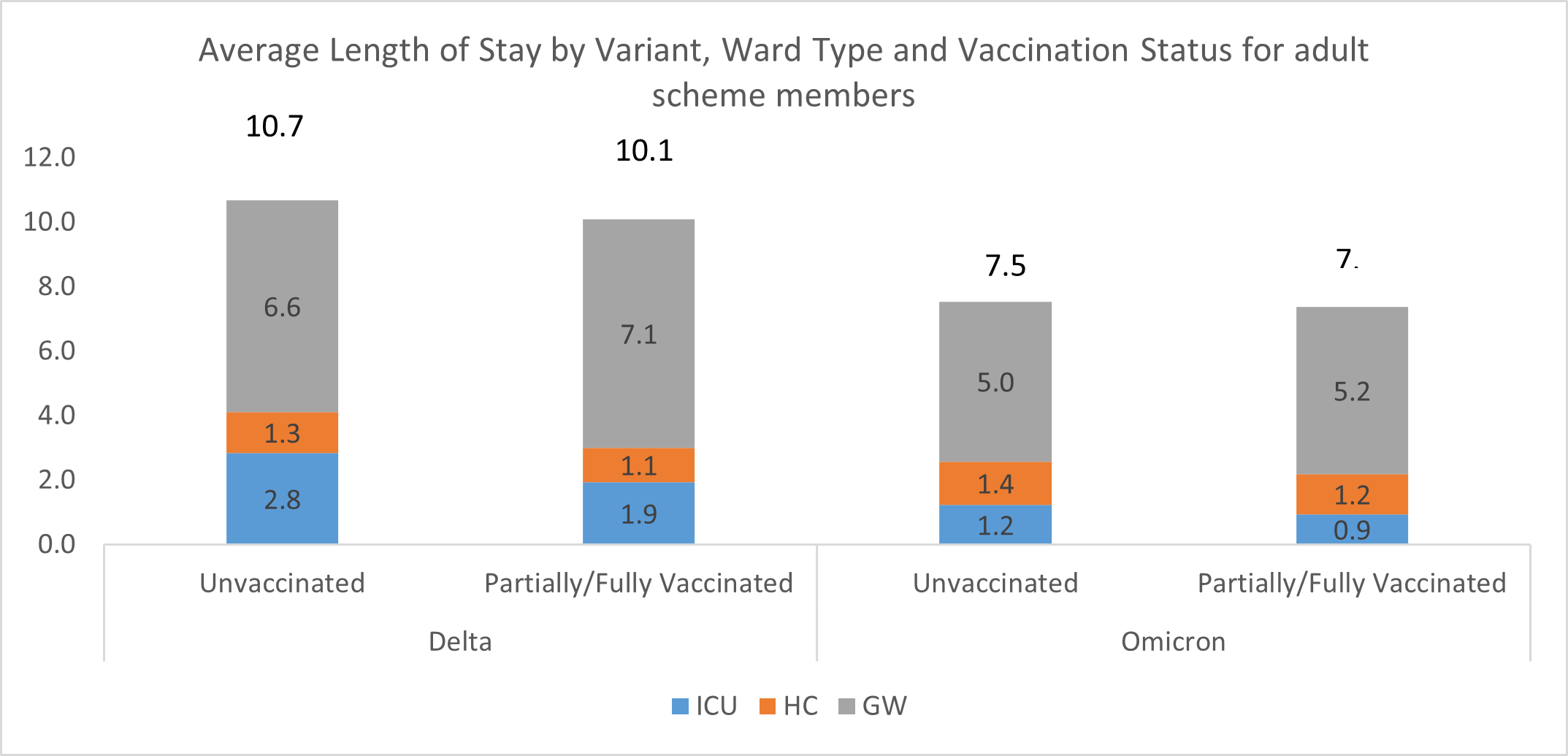
Figure 8: Average length of stay overall and by Ward Type (ICU, High Care, General Ward) and vaccination status for adult medical scheme members admitted during the Delta-driven third wave and Omicron-driven fourth wave
Final thoughts: Vaccination rates, seroprevalence and variant pathogenicity, all important dynamics that affect our data analysis
Though we did not adjust for confounding variables in this analysis, we did do so for investigation recent post (25 March 2022), which compared the severity of the Omicron-drive fourth wave relative to the Delta-driven wave, confirming the lowered severity of disease experienced over the fourth wave of infection. In other words, the data remains consistent in showing the lowered severity of the fourth wave of infection.
The Omicron (B.1.1.529)-driven fourth wave's lowered severity compared to past waves of infection is evident in:
- Lower admission rates for COVID-19 positive medical scheme members
- Less severe illness in those admitted, shown through:
- Shorter lengths of stay
- Fewer days spent in high acuity wards - ICU and High Care
- Less severe outcomes for partially or fully vaccinated individuals across these measures
Three elements contribute to the lower disease severity recorded in the fourth wave of infection, and affect our findings in ways that are difficult to quantify:
- The lowered pathogenicity of the Omicron variant compared to past Variants of Concern
- High seroprevalence (presence of COVID-19 antibodies which lead to immunity) in the South African population by the fourth wave:
- A recent study published in the New England Journal of Medicine - of 7010 Gauteng-based participants (18.8% of whom had been vaccinated) - found widespread underlying SARS-CoV-2 seropositivity before the Omicron-dominant fourth wave. This ranged from 56.2% in children under 12 to 79.7% in adults older than 50 years.
- Many global studies have shown higher seropositivity rates to exist than are indicated through national surveillance statistics. A South African study published in December 2021, estimated that 95% of COVID-19 infections were not reported to national surveillance. In reality, the extent to which underlying seroprevalence levels of SARS CoV-2 antibodies within the Discovery Health medical scheme member base contribute to our observations is unclear and complex to investigate.
- Population-wide COVID-19 vaccination rates by the end of 2021 - 39% of adults had been fully vaccinated at that stage
Our investigation recognises these dynamics and explores the available data with these in mind. We therefore attribute our findings to all of these variables.
More children (medical scheme members under 1), and specifically for younger children, were admitted to hospital in the Omicron-driven wave of infection than the Delta-driven third wave. Slightly more children (29%) than adults (26%) tested positive for COVID-19 during the fourth wave, possibly due to a return to in-person schooling, ineligibility of children under twelve for COVID-19 vaccinations, and the low vaccination rate amongst 12- to 17-year-old children.
It is important to mention of course that in absolute terms, a very small number of children experience severe COVID-19 manifestations. Testing for COVID-19 in kids is also less common than in adults, and so in real terms, the proportion of COVID-19 positive children that eventually require hospitalisation is extremely small. Despite these changes in Omicron relative to the other waves, children in general cope well with COVID-19 infections.
Appendix 1
The table below displays each wave's start and end date by province
| Dominant Variant | Province | Start date | End date |
|---|---|---|---|
| D614G | Eastern Cape | 01 March 2020 | 06 October 2020 |
| Beta | Eastern Cape | 07 October 2020 | 19 May 2021 |
| Delta | Eastern Cape | 20 May 2021 | 23 November 2021 |
| Omicron | Eastern Cape | 24 November 2021 | |
| D614G | Free State | 01 March 2020 | 06 December 2020 |
| Beta | Free State | 07 December 2020 | 27 March 2021 |
| Delta | Free State | 28 March 2021 | 25 November 2021 |
| Omicron | Free State | 26 November 2021 | |
| D614G | Gauteng | 01 March 2020 | 19 November 2020 |
| Beta | Gauteng | 20 November 2020 | 17 April 2021 |
| Delta | Gauteng | 18 April 2021 | 07 November 2021 |
| Omicron | Gauteng | 08 November 2021 | |
| D614G | Kwazulu Natal | 01 March 2020 | 17 November 2020 |
| Beta | Kwazulu Natal | 18 November 2020 | 19 May 2021 |
| Delta | Kwazulu Natal | 20 May 2021 | 22 November 2021 |
| Omicron | Kwazulu Natal | 23 November 2021 | |
| D614G | Limpopo | 01 March 2020 | 08 December 2020 |
| Beta | Limpopo | 09 December 2020 | 19 May 2021 |
| Delta | Limpopo | 20 May 2021 | 21 November 2021 |
| Omicron | Limpopo | 22 November 2021 | |
| D614G | Mpumalanga | 01 March 2020 | 02 December 2020 |
| Beta | Mpumalanga | 03 December 2020 | 29 April 2021 |
| Delta | Mpumalanga | 30 April 2021 | 20 November 2021 |
| Omicron | Mpumalanga | 21 November 2021 | |
| D614G | North West | 01 March 2020 | 25 November 2020 |
| Beta | North West | 26 November 2020 | 14 April 2021 |
| Delta | North West | 15 April 2021 | 16 November 2021 |
| Omicron | North West | 17 November 2021 | |
| D614G | Northern Cape | 01 March 2020 | 19 December 2020 |
| Beta | Northern Cape | 20 December 2020 | 06 April 2021 |
| Delta | Northern Cape | 07 April 2021 | 29 November 2021 |
| Omicron | Northern Cape | 30 November 2021 | |
| D614G | Western Cape | 01 March 2020 | 05 November 2020 |
| Beta | Western Cape | 06 November 2020 | 19 May 2021 |
| Delta | Western Cape | 20 May 2021 | 23 November 2021 |
| Omicron | Western Cape | 24 November 2021 |
Interested in knowing more or reporting on these findings?
Please contact us on MEDIA_RELATIONS_TEAM@discovery.co.za to request any updated data available since publication and to obtain any further context required.
Did you find this post interesting?
You may also be interested in reading our related post. This post covers the way in which having either two doses of either the Johnson & Johnson or two doses of the Pfizer COVID-19 vaccine delivers equal and good protection against developing serious illness from the Omicron B.1.1.529 variant (which drove South Africa's fourth wave of COVID-19 infection). Importantly, on 4 May the New England Journal of Medicine published correspondence relating this research, written by leading South African academic research teams and members of the Health Intelligence Unit at Discovery Health.
All information shared on this page is based on perspectives gained from analysis of figures and trends emanating from discovery health's data pool. The analysis, which is conducted by discovery health's actuarial and data scientist team, aims to encourage industry dialogue. This content is shared for educational and informational purposes only. It does not constitute peer-reviewed, published scientific research, and hence should not be interpreted as such or used as a basis for altering treatment decisions.
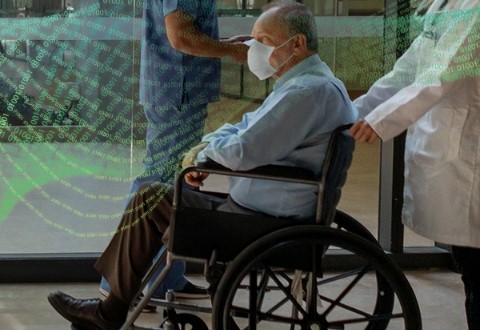
Long COVID symptoms, impact on carrying out daily activities: Survey of just over 7,000 medical scheme members reveals key insights
16 June 2022
Authors: Shirley Collie (Chief Healthcare Analytics Actuary, Discovery Health), Lizelle Steenkamp (Senior Healthcare Statistician, Discovery Health), Lebohang Radebe (Data Scientist, Discovery Health), Dr Smybinn Mathews (Clinician, Discovery Health) and Dr Dave Jacobs (Senior Clinician and Clinical Classification System Architect, Discovery Health)

Discovery's COVID-19 personal resilience index predicts an individual's resilience to serious COVID-19 illness
23 May 2022
Authors: Lizelle Steenkamp (Senior Healthcare Statistician at Discovery Health), Tommy Chen (Actuary at Discovery Health), Jared Champion (Senior Actuary at Discovery Health) and Donald Ntjana (Senior Data Scientist at Discovery Health)
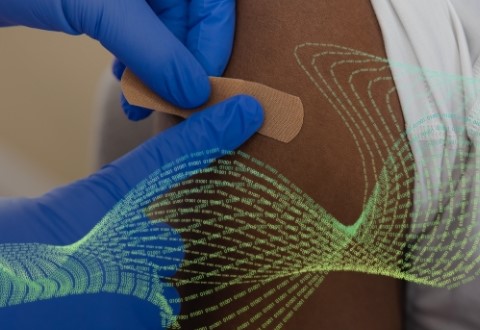
2 doses of the J&J or 2 doses of the Pfizer COVID-19 vaccine? New research out of South Africa reveals they're equally effective against serious illness caused by the Omicron variant.
18 May 2022
Two doses of either the Johnson & Johnson or Pfizer COVID-19 vaccine deliver equal levels of protection against serious illness caused by the Omicron variant. On 4 May the New England Journal of Medicine published correspondence on this front, by leading South African academic research teams and Discovery Health.